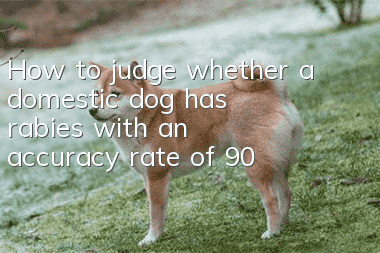How to judge whether a domestic dog has rabies with an accuracy rate of 90%

How to judge whether a domestic dog has rabies
1. Age of the dogA Less than 1 month old: no rabies
B More than 1 month old or unknown age: see Article 2< br />
2. The dog’s health status
A If it behaves normally within 10 days or if it is sick for more than 10 days: it is not rabies
B If it is sick for less than ten days or it is unknown: see Article 3
/>
3. Disease progression
A Acute onset from a normal healthy state: not rabies
B Gradual onset or unknown: see Article 4
4. Clinical symptoms in the last 3-5 days:
A Without any treatment, the condition is stable or continuously improving: not rabies
B Clinical symptoms or abnormalities continue to worsen or are unknown: see Article 5
5. The dog shows "circling" movements (often tripping or walking in circles, hitting its head against the wall, as if it is blind.)
A Appears: Not rabies
B No or unknown: See Item 6
6 Among the following 17 symptoms in the past week
A. Two or more words appear: it is rabies
B. None or only one: not rabies
1. Drooping chin (lower jaw),
2. Abnormal barking
3. Tongue protruding, drooping, and large amounts of saliva flowing.
4. Lick your own urine
5. Abnormal licking
6. Nausea
7. Changes in behavior
8. Bite or eat unusual things
9. Being aggressive (such as biting)
10. Injuring without provocation
11. Running wildly for no apparent reason
12. Stiff posture when walking or running
13. Irritability
14. Biting during isolation
15. Drowsiness and falling asleep
16. Unbalanced walking gait
17. Sitting on a dog Frequent demonstrations in standing positions.
Random articles
- How much does a golden retriever eat in a month?
- Can dogs eat red dates?
- What to do if your Irish Red and White Setter has a cough
- Teddy's mood changes during estrus
- When should male Bichon Frize dogs be neutered?
- Dog cerebral hemorrhage risk period
- Dogs have poor appetite in autumn. Four tips to increase their appetite.
- Belvedere dog flea removal and tick removal are also very effective!
- Can dogs eat cake and cream? It turns out there are so many dangers to dogs eating cake and cream
- How many months into pregnancy do dogs give birth?



